
This is a teacher-created resource. It is a literacy activity that talks about the Aztec connection to Utah.
- Subject:
- Social Science
- Material Type:
- Activity/Lab
- Reading
- Provider:
- Jordan School District
- Date Added:
- 11/09/2023
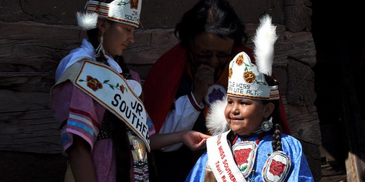

This is a teacher-created resource. It is a literacy activity that talks about the Aztec connection to Utah.
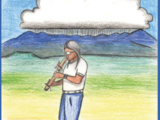
In traditional Ute culture, the flute was used for healing ceremonies, or sometimes for courting. A man would play a song to win the heart of a woman. According to tradition, only she could hear the music being played for her. The White Mesa Utes, located in White Mesa, Utah, are members of the Ute Mountain Ute tribe. The Ute Mountain Ute tribal headquarters are located about 90 miles east, in Towoac, Colorado. This Ute Mountain Ute booklet is part of the Native American Indian Literacy Project storybook series for the six main Utah Tribal Nations. The project was led by Shirlee A. Silversmith, American Indian education specialist for the Utah State Office of Education. There are five stories per Tribe, with a total of 30 booklets, plus an ABC book. The set of Indian Tribal stories may be utilized by elementary classroom teachers to (1) develop an understanding and appreciation of Native American culture and societal contributions (2) provide a genre of text for the application of reading strategies, and (3) facilitate the mastery of various Utah Core Content Curriculum objectives. The Native American Indian Literacy Project was made possible by funds from the Utah State Office of Education (USOE). It is a joint effort of the USOE and San Juan School District Media Center.
The original set has 30 booklets, measuring 5.5” x 8.5” each, and illustrated by tribal members. The booklets were formatted to be printed and assembled. This version of the book has been updated to accommodate using a projector or smart board with pages appearing in order.
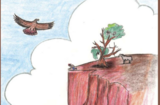
The Ute people have a close association with nature and a respect for all living things. They share the earth with animals, and they look to them for guidance. The Utes honor the hawk in ceremonies, and they use hawk feathers in their regalia. This Ute Mountain Ute booklet is part of the Native American Indian Literacy Project storybook series for the six main Utah Tribal Nations. The project was led by Shirlee A. Silversmith, American Indian education specialist for the Utah State Office of Education. There are five stories per Tribe, with a total of 30 booklets, plus an ABC book. The set of Indian Tribal stories may be utilized by elementary classroom teachers to (1) develop an understanding and appreciation of Native American culture and societal contributions (2) provide a genre of text for the application of reading strategies, and (3) facilitate the mastery of various Utah Core Content Curriculum objectives. The Native American Indian Literacy Project was made possible by funds from the Utah State Office of Education (USOE). It is a joint effort of the USOE and San Juan School District Media Center.
The original set has 30 booklets, measuring 5.5” x 8.5” each, and illustrated by tribal members. The booklets were formatted to be printed and assembled. This version of the book has been updated to accommodate using a projector or smart board with pages appearing in order.

To the Ute people, the bear, quee yahgudt, is a sacred animal. He gave the Ute people their Bear Dance, which is held in the springtime after the first thunder. This Ute (Uintah/Ouray) booklet is part of the Native American Indian Literacy Project storybook series for the six main Utah Tribal Nations. The project was led by Shirlee A. Silversmith, American Indian education specialist for the Utah State Office of Education. There are five stories per Tribe, with a total of 30 booklets, plus an ABC book. The set of Indian Tribal stories may be utilized by elementary classroom teachers to (1) develop an understanding and appreciation of Native American culture and societal contributions (2) provide a genre of text for the application of reading strategies, and (3) facilitate the mastery of various Utah Core Content Curriculum objectives. The Native American Indian Literacy Project was made possible by funds from the Utah State Office of Education (USOE). It is a joint effort of the USOE and San Juan School District Media Center.
The original set has 30 booklets, measuring 5.5” x 8.5” each, and illustrated by tribal members. The booklets were formatted to be printed and assembled. This version of the book has been updated to accommodate using a projector or smart board with pages appearing in order.

Stories with morals, like "Coyote and Bobcat," were often used by the Ute Mountain Ute people to teach their children about proper behavior and the consequences of their own actions. Coyote tales are only told during the winter time. This Ute Mountain Ute story booklet is part of the Native American Indian Literacy Project storybook series for the six main Utah Tribal Nations. The project was led by Shirlee A. Silversmith, American Indian education specialist for the Utah State Office of Education. There are five stories per Tribe, with a total of 30 booklets, plus an ABC book. The set of Indian Tribal stories may be utilized by elementary classroom teachers to (1) develop an understanding and appreciation of Native American culture and societal contributions (2) provide a genre of text for the application of reading strategies, and (3) facilitate the mastery of various Utah Core Content Curriculum objectives. The Native American Indian Literacy Project was made possible by funds from the Utah State Office of Education (USOE). It is a joint effort of the USOE and San Juan School District Media Center.
The original set has 30 booklets, measuring 5.5” x 8.5” each, and illustrated by tribal members. The booklets were formatted to be printed and assembled. This version of the book has been updated to accommodate using a projector or smart board with pages appearing in order.

The buffalo was a giver of life to the Ute people. It is a sacred animal and part of the circle of life. Every part of the buffalo was used; nothing was wasted. For example, the hides were used for blankets and for covering the teepee and sweat lodge. The hooves were used for making utensils. When the Utes first encountered African Americans, they referred to them as "buffalo people,: because their curly hair resembled the curly hair on the mane of the buffalo. According to Ute tradition, Coyote stories should only be told during the winter time. This Ute (Uintah/Ouray) booklet is part of the Native American Indian Literacy Project storybook series for the six main Utah Tribal Nations. The project was led by Shirlee A. Silversmith, American Indian education specialist for the Utah State Office of Education. There are five stories per Tribe, with a total of 30 booklets, plus an ABC book. The set of Indian Tribal stories may be utilized by elementary classroom teachers to (1) develop an understanding and appreciation of Native American culture and societal contributions (2) provide a genre of text for the application of reading strategies, and (3) facilitate the mastery of various Utah Core Content Curriculum objectives. The Native American Indian Literacy Project was made possible by funds from the Utah State Office of Education (USOE). It is a joint effort of the USOE and San Juan School District Media Center.
The original set has 30 booklets, measuring 5.5” x 8.5” each, and illustrated by tribal members. The booklets were formatted to be printed and assembled. This version of the book has been updated to accommodate using a projector or smart board with pages appearing in order.

The Ute Mountain Ute people live in southeastern Utah and southwestern Colorado, near the base of Wisuv Káruv, or Sleeping Ute Mountain. The Ute Mountain Ute tribal headquarters are located at Towaoc, Colorado. The Ute Mountain Ute Sun Dance is held there every year on Sleeping Ute Mountain. This Ute Mountain Ute booklet is part of the Native American Indian Literacy Project storybook series for the six main Utah Tribal Nations. The project was led by Shirlee A. Silversmith, American Indian education specialist for the Utah State Office of Education. There are five stories per Tribe, with a total of 30 booklets, plus an ABC book. The set of Indian Tribal stories may be utilized by elementary classroom teachers to (1) develop an understanding and appreciation of Native American culture and societal contributions (2) provide a genre of text for the application of reading strategies, and (3) facilitate the mastery of various Utah Core Content Curriculum objectives. The Native American Indian Literacy Project was made possible by funds from the Utah State Office of Education (USOE). It is a joint effort of the USOE and San Juan School District Media Center.
The original set has 30 booklets, measuring 5.5” x 8.5” each, and illustrated by tribal members. The booklets were formatted to be printed and assembled. This version of the book has been updated to accommodate using a projector or smart board with pages appearing in order.
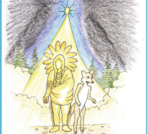
Coyote is a trickster. He tries to trick the people, but they already know what he is capable of doing and how far he will go to get his way. He has a bag full of tricks. This story should only be told during the winter months. This Ute Mountain Ute story booklet is part of the Native American Indian Literacy Project storybook series for the six main Utah Tribal Nations. The project was led by Shirlee A. Silversmith, American Indian education specialist for the Utah State Office of Education. There are five stories per Tribe, with a total of 30 booklets, plus an ABC book. The set of Indian Tribal stories may be utilized by elementary classroom teachers to (1) develop an understanding and appreciation of Native American culture and societal contributions (2) provide a genre of text for the application of reading strategies, and (3) facilitate the mastery of various Utah Core Content Curriculum objectives. The Native American Indian Literacy Project was made possible by funds from the Utah State Office of Education (USOE). It is a joint effort of the USOE and San Juan School District Media Center.
The original set has 30 booklets, measuring 5.5” x 8.5” each, and illustrated by tribal members. The booklets were formatted to be printed and assembled. This version of the book has been updated to accommodate using a projector or smart board with pages appearing in order.
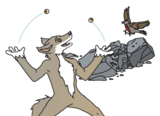
When the earth was new, there were no people, only the animals. The animals had human characteristics, and they were able to speak to one another. Coyote was often the trickster and had to learn the hard way. The Ute people tell stories about Coyote and other animals to their children. Based on Coyote's mistakes, the elders teach children about proper behavior and positive attitudes. The lessons learned help them avoid making the same mistakes Coyote did and suffering the consequences in their own lives. This Ute(Uintah/Ouray) story booklet is part of the Native American Indian Literacy Project storybook series for the six main Utah Tribal Nations. The project was led by Shirlee A. Silversmith, American Indian education specialist for the Utah State Office of Education. There are five stories per Tribe, with a total of 30 booklets, plus an ABC book. The set of Indian Tribal stories may be utilized by elementary classroom teachers to (1) develop an understanding and appreciation of Native American culture and societal contributions (2) provide a genre of text for the application of reading strategies, and (3) facilitate the mastery of various Utah Core Content Curriculum objectives. The Native American Indian Literacy Project was made possible by funds from the Utah State Office of Education (USOE). It is a joint effort of the USOE and San Juan School District Media Center.
The original set has 30 booklets, measuring 5.5” x 8.5” each, and illustrated by tribal members. The booklets were formatted to be printed and assembled. This version of the book has been updated to accommodate using a projector or smart board with pages appearing in order.

Just as the birds in this story held a council meeting to decide how to deal with Buzzard, Ute people, to this day, have council meetings to discuss problems and solutions for their people. At these meetings, everyone has the right to express his or her opinion and be heard and listened to. Although some Native American Indian stories can only be told during the winter time, this story can be told any time of the year. This Ute (Uintah/Ouray) booklet is part of the Native American Indian Literacy Project storybook series for the six main Utah Tribal Nations. The project was led by Shirlee A. Silversmith, American Indian education specialist for the Utah State Office of Education. There are five stories per Tribe, with a total of 30 booklets, plus an ABC book. The set of Indian Tribal stories may be utilized by elementary classroom teachers to (1) develop an understanding and appreciation of Native American culture and societal contributions (2) provide a genre of text for the application of reading strategies, and (3) facilitate the mastery of various Utah Core Content Curriculum objectives. The Native American Indian Literacy Project was made possible by funds from the Utah State Office of Education (USOE). It is a joint effort of the USOE and San Juan School District Media Center.
The original set has 30 booklets, measuring 5.5” x 8.5” each, and illustrated by tribal members. The booklets were formatted to be printed and assembled. This version of the book has been updated to accommodate using a projector or smart board with pages appearing in order.

This lesson enhances vocabulary acquisition and learning about how the Earth rotates on its axis and revolves around the Sun by reading the story, "Cottontail Shoots the Sun," a traditional tale shared by the Ute Indian Tribe of the Uintah and Ouray Reservation. It also helps students become familiar with cultural storytelling and its importance in Native cultures. Students will have a brief introduction to the Ute Indian Tribe of the Uintah and Ouray Reservation, its location, and partnership with the University of Utah. Then students will particpate in the group reading of the book and a STEM lesson learning about observable patterns in the sky.
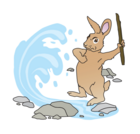
This lesson shares a Ute tale with students to help them to use illustrations to help clarify text details and sequence. The story is then used to help engage students in a discussion on bullying, how actions have consequences and what the characteristics are of a good friend.Background information gives teachers resources to help their students learn more about the Ute Indian Tribe of the Uintah and Ouray Reservation. The lesson is an integrated English Language Arts, Social Studies, Health lesson.
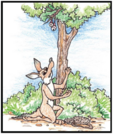
According to Goshute and Ute tradition, Coyote tales should only be told during the winter time. The tribes ask that the teacher use this lesson and story in the winter months. This lesson utilizes the Confederated Tribes of the Goshute (CTGR) tale, “Coyote Loses His Eyes” and the Ute Indian Tribe of the Uintah and Ouray Reservation (UIT) tale, “The Eye Juggler Coyote” to enhance comprehension skills and provide an introduction to comparing and contrasting plot, characters, theme and setting. The students will also be introduced to similarities and differences between the two tribes. Lastly, students will write a response summarizing using compare and contrast key words.Native peoples tell stories about Coyote and other animals to their children. Based on Coyote’s mistakes, the elders teach children about proper behavior and positive attitudes. The lessons taught help children to avoid making the same mistakes as Coyote and suffering the consequences in their own lives.
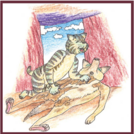
The Ute Mountain Ute people are one of three Ute tribes living in southeastern Utah and southwestern Colorado. The Ute Mountain Ute tribal headquarters are located at Towaoc, Colorado.Stories with morals, like “Coyote and Bobcat,” were often used by the Ute Mountain Ute people to teach their children about proper behavior and the consequences of their own actions. Coyote tales are only told during the winter time.
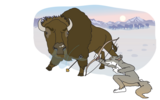
The Ute Indian Tribe of the Uintah and Ouray Reservation (UIT) tale, “Coyote and the Buffalo” is read and used to enhance comprehension skills, provide an introduction to the importance of the bison to Native people and gives examples of how choices impact consequences. An activity to explore how Indigenous peoples used different parts of the bison helps students to recognize the ingenuity and creativity of Native Americans.The Ute people tell stories about Coyote and other animals to their children. Based on Coyote’s mistakes, the elders teach children about proper behavior and positive attitudes. The lessons learned help them avoid making the same mistakes Coyote did and suffering the consequences in their own lives. According to Ute tradition, Coyote stories should only be told during the winter time.
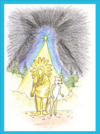
This is a story from the Ute Mountain Ute Tribe. The purpose of Native American stories is not only to entertain, their primary purpose is to educate. Our story teaches a lesson about what happens to Coyote when he chooses to be irresponsible. Coyote is a trickster. He tries to trick the people, but they already know what he is capable of doing and how far he will go to get his way. He has a bag full of tricks. This story and all other Coyote Stories should only be told during the winter months.
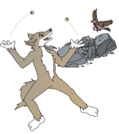
This lesson utilizes the Ute Indian Tribe of the Uintah and Ouray Reservation (UIT) tale, “The Eye Juggler Coyote” to enhance comprehension skills, provide an introduction to how force affects motion and give information about the UIT. The students will read the tale and then use the story to learn about gravity and balanced forces. The connection of the Ute people to the bison will also be explored. The Ute people tell stories about Coyote and other animals to their children. Based on Coyote’s mistakes, the elders teach children about proper behavior and positive attitudes. The lessons learned help them avoid making the same mistakes Coyote made and suffering the consequences in their own lives.
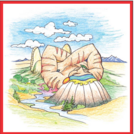
Our earth has so many different intersting facts about land formations and the impact of those landforms on our communities. Students will practice identifying different landforms and focus on one landform through a Native American story - "The Legend of the Sleeping Ute: A Ute Mountain Ute Tale"The Ute Mountain Ute people are one of three Ute tribes living in southeastern Utah and southwestern Colorado. The Ute Mountain Ute tribal headquarters are located at Towaoc, Colorado.
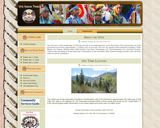
Homepage for the Northern Ute Tribe, with links to current information regarding, and affecting, tribal life.
Students will become familiar with the Ute Indians both past and present.Enduring Understandings:Who the Ute Indians were and their significance in Utah history.What the Ute culture was like before European expansion.How things are different today for the Ute Indians today compared to the past